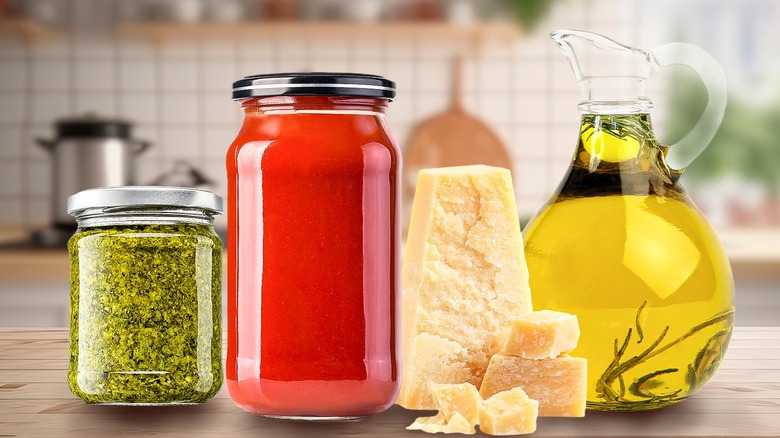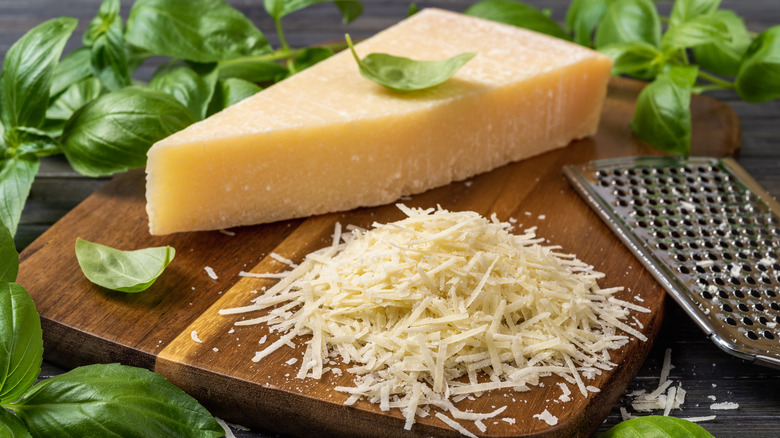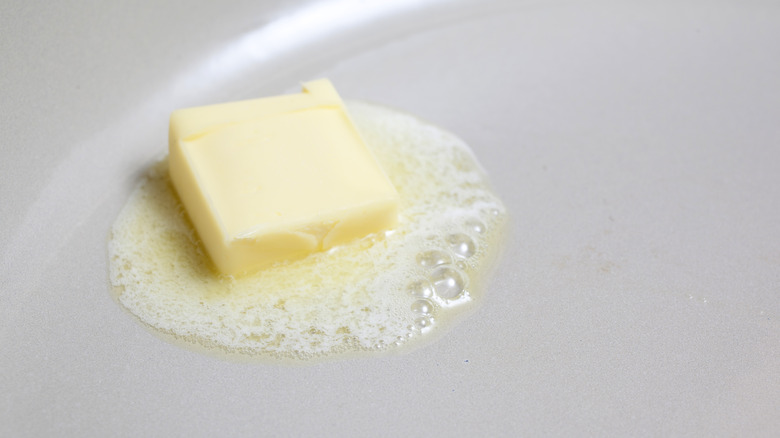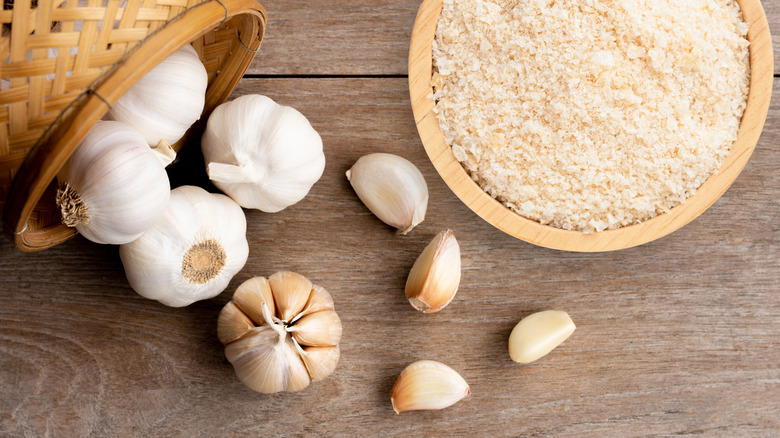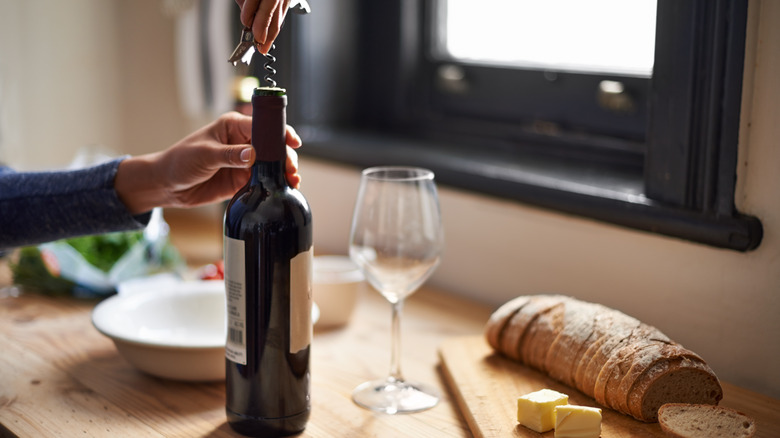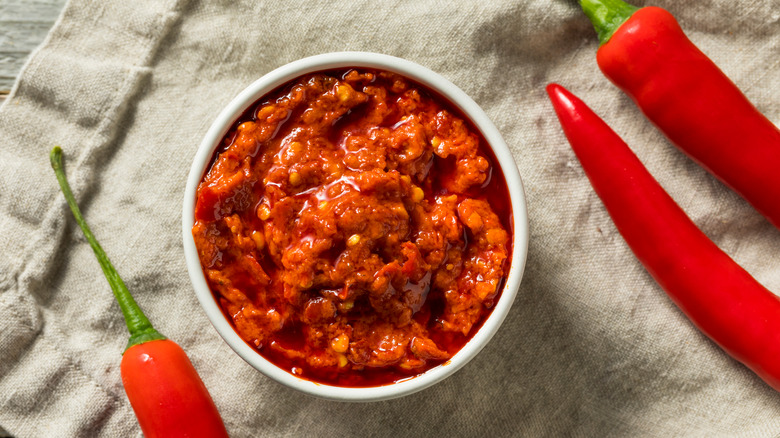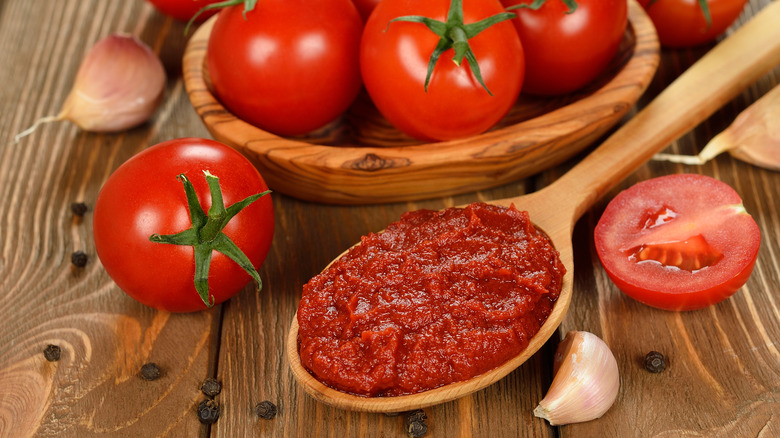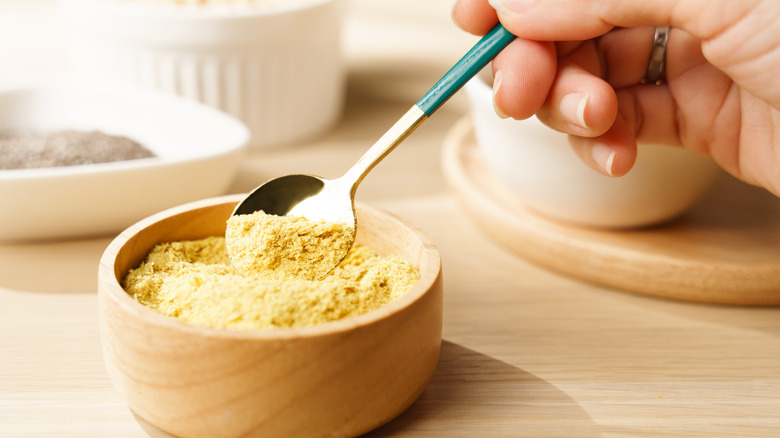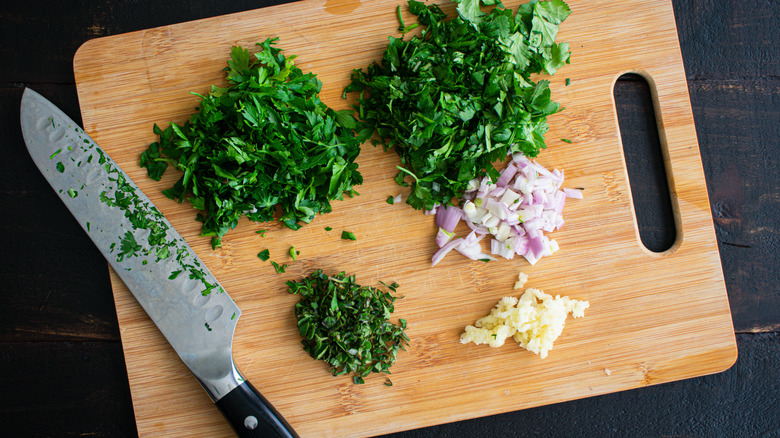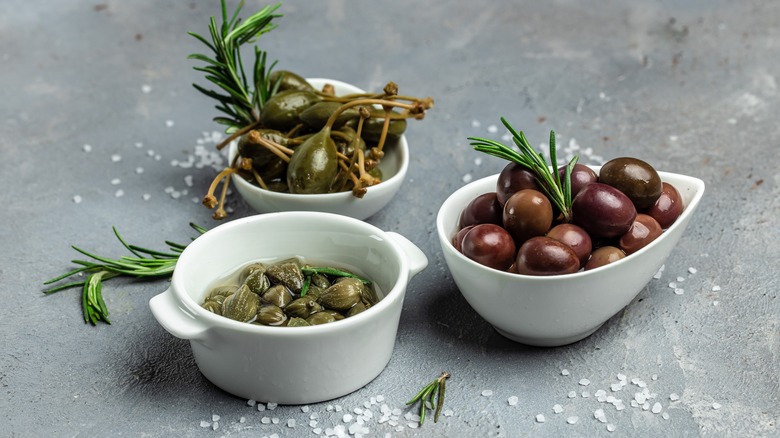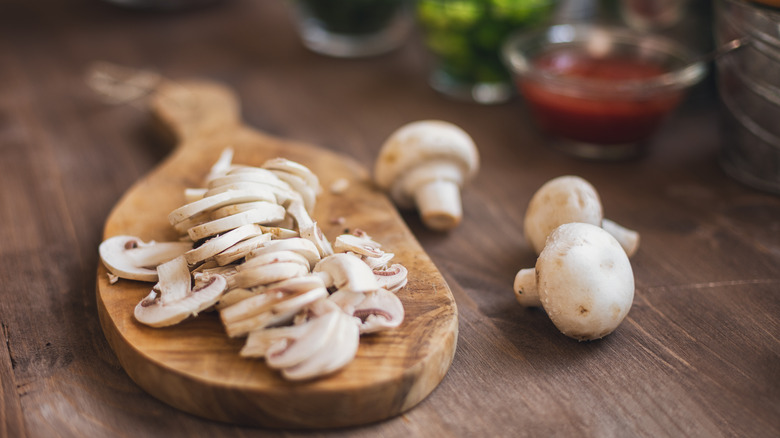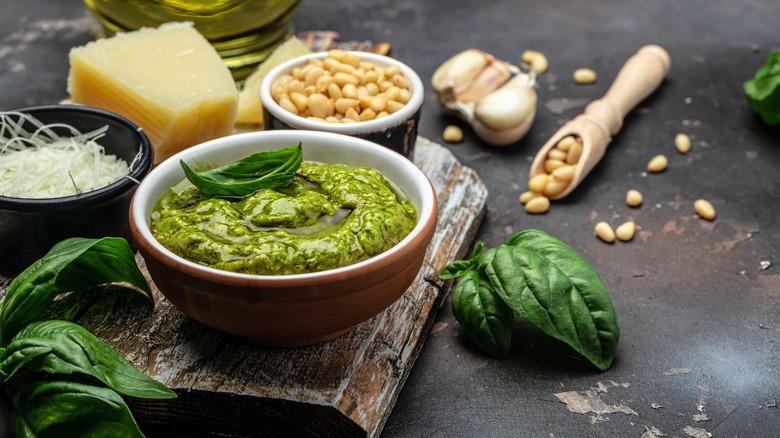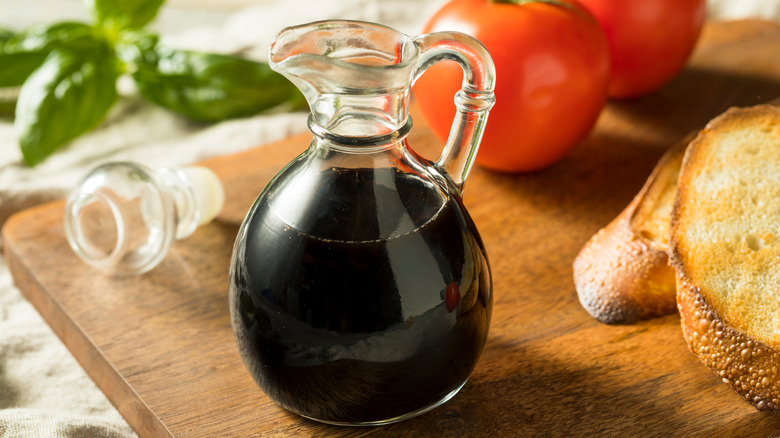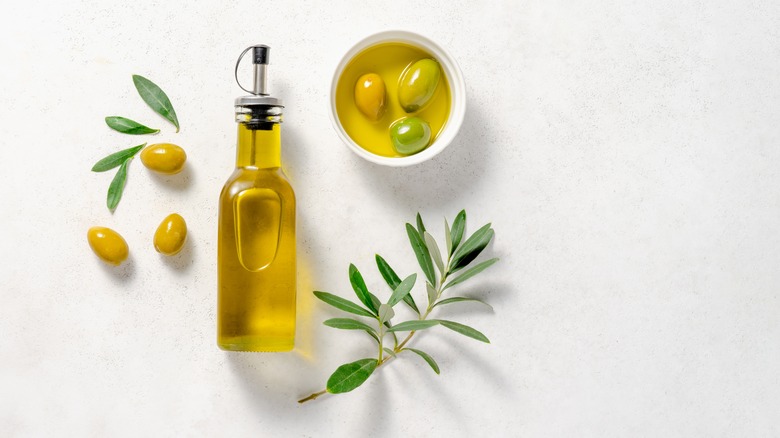13 Ways To Upgrade The Flavor Of Store-Bought Pizza Sauce
Pizza is loved by many for its delicious flavor, versatility, and ease. After all, in its simplest form, all that's required is dough, cheese, and sauce. But when a recipe is simple, it's harder to mask imperfections — and problems with taste and texture can be especially tricky to anticipate when buying store-bought pizza sauce. You don't quite know what you're working with until you pop open a can or jar at home.
Fortunately, there are several ways to upgrade store-bought pizza sauce. Many methods require just pantry staples, like garlic powder and olive oil. Others are classic tips for making your own pizza sauce, like using fresh herbs, rich ingredients like Parmesan, and even red wine. These recommendations suit all levels of cooking skills and allow for plenty of experimentation. Have fun, taste test along the way, and remember that, when it comes to pizza, it's hard to go wrong.
1. Mix in Parmesan cheese for a greater depth of flavor
Parmesan cheese is the ingredient that will change your pizza sauce forever. This savory, umami-rich addition will complement tomatoes' sweetness and acidity, creating a balanced and delicious depth of flavor. Additionally, Parmesan will form a thicker consistency and help ensure a crisp, chewy crust — rather than a soggy one that can result from a runny store-bought pizza sauce.
You can play with texture when incorporating Parmesan by folding in grated or shredded cheese, or using a blender to create a smooth, silky sauce. You can also experiment with flavor by exposing the sauce to heat. Most store-bought pizza sauce options are made with uncooked ingredients, resulting in a brighter, fresher taste. But some argue that simmering pizza sauce on the stovetop allows its flavors to meld and develop.
If you prefer the latter, consider the ingredient Giada De Laurentiis adds to store-bought sauce: a Parmesan rind. Not only does this cut down on food waste, but the rind boosts flavor in the same way that grated Parmesan would. Simply drop one into your sauce and let it stew away to your preference. However, remember that most often, your sauce will be heated again in the oven, and overcooking can lead to a bitter taste. Simmer with caution or consider making a Detroit-style pie, which involves pouring the sauce on after the crust and toppings have par-baked, limiting its cook time in the oven.
2. Stir in melted butter to balance acidity
Butter is the rich addition that will take your pizza sauce to the next level. A pat or two will balance any sour notes in your store-bought sauce and further enhance its flavor with a subtle sweetness. However, the addition doesn't have to be understated. Rather than a standard stick of butter, consider using savory, seasoned varieties like garlic butter and herbaceous blends.
There are many ways to add flavor to butter at home, and most recipes whip together in just minutes with the help of a stand or hand mixer. But like store-bought pizza sauce, there are plenty of ready-made compound butters available at grocery stores that will save you a few dishes and a bit of time. Regardless of what flavor you choose, butter will add a velvety, creamy texture to your sauce.
To use this ingredient, melt your preferred amount of butter in the microwave. Pour the melted butter and sauce into a bowl and stir until they're combined. Alternatively, you can add your store-bought sauce and a small amount of butter to a saucepan, then heat the mixture on the stovetop until it's emulsified. But again, if you choose to heat your pizza sauce, do so mindfully so that it doesn't overcook in the oven.
3. Add garlic powder for a smooth and well-seasoned sauce
Many homemade pizza sauces, like this extra-flavorful pizza sauce recipe, call for fresh garlic. Of course, you could go that route when upgrading a store-bought sauce, too. But to avoid a pungent sharpness, you'll want to mince and cook your garlic cloves, then incorporate your pizza sauce. Most home chefs are unlikely to be daunted by this process, but these steps can be easily skipped without sacrificing flavor.
The addition of garlic powder will take your pizza sauce up a notch, and few hacks are as effortless. Simply sprinkle the seasoning into your store-bought sauce, starting with a ½ teaspoon. If needed, add more to suit your taste, but remember that you don't want your sauce to be too overpowering — it should complement, not outshine, your pizza toppings.
Unlike the fresh ingredient, garlic powder ensures a smooth, easy-to-spread consistency, as well as a consistent flavor. It's not only a convenient solution but an affordable staple that you're likely to use in a wide variety of recipes. Chances are you already have it readily available in your pantry.
4. Pour in red wine for a more robust taste
Seriously upgrade store-bought pizza sauce with a boozy ingredient: red wine. This addition will create a rich aroma and deeper, more complex flavor, especially when it's exposed to heat. Either reduce the wine in a saucepan over the stovetop, then stir the concentrated liquid into your store-bought sauce; or simply warm the two together on the stove simultaneously. Regardless of which method you choose, start with about a ¼ cup of wine per jar of store-bought pizza sauce, which is usually around 14 ounces.
Keep in mind that the sauce will pick up the nuanced flavors of the wine you choose, so cooking with a wine that you enjoy drinking is a good rule of thumb. Though, you may want to especially consider using pinot noir, zinfandel, or cabernet sauvignon varieties. They're some of the best red wines for cooking and beautifully complement tomato-based sauces. Chianti is another ideal pick, especially for those who aren't accustomed to cooking with wine. It's a forgiving varietal — even if you accidentally pour in a bit too much, your sauce won't turn bitter. Rather, Chianti will add a subtle fruity flavor and earthy quality.
This tip includes an added bonus: You'll already have a bottle open and ready for when your pizza comes out of the oven. Many would agree that there are few better pairings than a glass of vino and Italian flavors.
5. Blend in Calabrian chile peppers for a spicy kick
Give your pizza sauce a spicy kick with Calabrian chiles. These vibrant peppers pack on heat, as well as a fruity, smoky flavor that complements a number of pizza toppings, like roasted red peppers, mushrooms, and salty meats.
You can use raw Calabrian chiles in your pizza sauce by dicing them finely, before sauteing them in a pan with a touch of heated oil. Once the peppers are softened, add them to the sauce. You can leave the texture as-is or use an immersion blender for a smooth consistency. More than likely, one pepper will suffice if using a standard-sized jar of pizza sauce. But the quantity of Calabrian chiles needed depends on your preference. Note that Calabrian chiles' spice level is between a jalapeño and a cayenne pepper, and most of their capsaicin is in their seeds — which can be removed if using fresh produce.
However, for greater convenience, you might prefer Calabrian chile paste or oil-based jars containing the chopped pepper. Both are available at grocery stores, and the latter comes especially recommended by restaurateur and chef Bobby Flay. He uses Mutti sauce and jazzes it up with jarred Calabrian chile peppers, red pepper flakes, fresh herbs, and aged parmesan.
6. Whisk in tomato paste for a thicker texture
When shopping for store-bought pizza sauce, it may be tempting to think that options made with fresh tomatoes are more premium than tomato paste-based sauces. But Tasting Table's ranking of grocery store pizza sauce brands debunked this belief. Muir Glen organic pizza sauce placed second among the competitors despite its use of water and tomato paste, and it scored particularly well in the areas of flavor and consistency.
Tomato paste is not an inferior ingredient — in fact, it can be a useful tool in upgrading the taste and texture of store-bought pizza sauce. The addition will increase your sauce's hearty tomato flavor and thickness, making it easy to spread on what will be a properly crisp crust. For the best result, use a quality product and consider browning your tomato paste before incorporating it into your sauce. To do so, simply heat a small amount of oil in a pan, then add your tomato paste and cook until caramelized, which is evident in its bright red color darkening. Of course, this extra step isn't necessary, but you may find that it creates a more robust flavor.
7. Sprinkle in nutritional yeast for a protein-packed sauce
Nutritional yeast is the key ingredient for a more flavorful pizza sauce — and a healthier one, too. Also known as nooch, 2 tablespoons of nutritional yeast — which is about how much you'll want to add to a jar of store-bought pizza sauce — will feature an impressive 8 grams of protein. That quantity also contains roughly 20% of your daily dose of fiber, plus around three times your recommended daily amount of vitamin B12.
Along with a nutritional boost, this ingredient will add an umami-rich, cheesy flavor (similar to the way parmesan would) to your pizza sauce. However, nutritional yeast accommodates those who are lactose intolerant, along with folks who follow a plant-based diet. In fact, including a sprinkle of nooch is one of the top tips for making a flavorful vegan pizza. Though, any type of pie can benefit from this savory, nutrient-dense addition.
Simply stir the flaky, yellow-hued ingredient into your store-bought pizza sauce and spread the mixture over your crust. The papery flakes will dissolve and not change the sauce's texture. Visibly, you may not even notice a difference, but its enhanced flavor will be deliciously evident.
8. Toss in aromatics like chopped onion and fresh herbs
Some store-bought pizza sauces are well-seasoned right out of the can or jar. However, others are lacking, even when it comes to common additions like garlic, onion, and oregano. But either way, a few fresh ingredients can reinvigorate the flavor of ready-made pizza sauce — and while peeling, dicing, and sauteing may be more laborious than other suggestions on this list, it's easier than making sauce from scratch. Yet the result may fool even the most discerning palette into believing it's completely homemade.
To start, look at the ingredients listed on your store-bought sauce. If some aromatics are already included, you might want to use a lighter hand. Still, don't be shy about adding a few tablespoons of caramelized onions or a dash of onion powder for greater ease. Fresh or dried herbs can make a big difference in flavor, too. Toss in a few basil leaves or a sprig of oregano, rosemary, or thyme. Alternatively, you can simply shake Italian seasoning into your sauce for a combination of all four herbs. Keep in mind that dried spices can be easily stirred in, whereas sauteed ingredients should be blended into the sauce for a smooth consistency.
Depending on your pizza toppings, you could get a little more creative with your aromatic additions. For example, this Italian sausage and sweet potato pizza recipe could incorporate several unique ingredients into its sauce, like spicy peppers, fresh sage, or extra fennel.
9. Stir in olives and capers for a puttanesca-inspired sauce
There's a big difference between pizza and pasta sauce. Namely, store-bought pizza sauce is often uncooked, whereas pasta sauce is typically exposed to heat prior to canning. Additionally, pizza sauce is often thicker, allowing it to be more easily spread and to prevent a soggy crust. Still, this doesn't mean you can't take cues from classic pasta recipes when looking to elevate your store-bought pizza sauce.
To easily make a flavorful puttanesca-inspired sauce, mix in capers and olives. Experiment with various types of the latter, such as rich Kalamata olives or buttery Castelvetranos, remembering to remove any pits. Finely chop the ingredients and leave the texture as-is, or use an immersion blender to create a smooth, briny sauce that will complement a number of pizza toppings. Think salty anchovies, peppery arugula, seared strips of chicken, or sun-dried tomatoes. Other classic Mediterranean ingredients like eggplant and artichokes would be tasty additions, too.
10. Incorporate mushrooms for a boost of umami richness
Mushrooms are one of the best umami boosters for store-bought tomato sauce. For the greatest ease and to avoid cooking your sauce, opt for dried mushrooms. This pantry staple may be more costly than fresh mushrooms, but it's long-lasting and practically effortless to prepare. Simply rehydrate them in warm water for about 30 minutes, then rinse your dried mushrooms to remove any grit. Next, blend them into your pizza sauce until the mixture is smooth, and be amazed by the robust result.
You can also chop fresh mushrooms and saute them in a lightly oiled pan until they're caramelized and reduced in size by about half. You'll know they're done once most of their moisture has evaporated. Once thoroughly cooked, you can mix the mushrooms into your sauce, leaving a bit of texture, or blend them to create an even consistency.
Nearly any type of edible mushroom will work for this tip, but we recommend especially seeking out umami-rich types like porcini, shiitake, and portobello, as well as maitake and morel mushrooms. You'll want to consider your pizza toppings, too. For example, this roast mushroom pizza recipe calls for oyster mushrooms — another variety that can amplify the flavor of your store-bought pizza sauce.
11. Marry pesto with your sauce for added brightness
Pesto is one of the most delicious alternatives for classic pizza sauce, but why not use both? After all, the key components found in classic pesto — basil, garlic, lemon, pine nuts, and parmesan — complement the flavor of tomato-based pizza sauce beautifully. You can easily blitz these ingredients together with olive oil in a food processor, creating a traditional homemade spread. But from-scratch recipes also allow you to play with flavors. Maybe you'd add fresh cilantro, a few tangy capers, or a pinch of chili flakes. Homemade pestos also give you the option to cut costs with the use of spinach instead of basil, or sunflower seeds instead of pine nuts.
Still, you could also buy ready-made pesto to save yourself some time and effort. Grocery stores have plenty of options on both shelves and in the refrigerated section. Some store-bought pestos are even plant-based or nut-free, offering convenience to those with dietary restrictions.
To try this idea, simply fold your pizza sauce and pesto into one flavorful mixture before spooning it onto your crust. Alternatively, you can layer on your pizza sauce, and then drizzle on your preferred amount of pesto for greater variation in flavor. The latter approach is more common; for example, see this cheesy eggplant parmesan pizza recipe. But ultimately, it comes down to personal preference, as either method will similarly upgrade your store-bought sauce.
12. Add balsamic vinegar to balance sweetness
There's a secret ingredient that makes pizza sauce restaurant-worthy, and it's likely already in your pantry: balsamic vinegar. Both it and tomatoes are deliciously acidic, but a quality balsamic vinegar will also add depth, complexity, and even a touch of smokiness. It also can fix an overly sweet tomato sauce, a characteristic you'll find in certain store-bought pizza sauce brands.
Though, it's important to remember that balsamic vinegar is quite pungent. Start by adding just a teaspoon to a jar of store-bought pizza sauce, then give it a taste and carefully stir in more, if necessary. You want the balsamic vinegar to act as a complement, not overpower the sauce. When done properly, the flavorful result will go with just about any pizza topping. But if you do accidentally pour in a touch too much, you can counter any sour notes with a pinch of sugar — the scale goes both ways!
13. Infuse a good glug of olive oil for a greater flavor
Last but certainly not least, there's olive oil. This versatile ingredient is a must-have for any home cook, and it's also a staple during pizza night. Brush your pan with olive oil so that your pie doesn't stick, use it to baste your dough to add more flavor to your pizza crust, and yes, combine it with your store-bought sauce. Start with a thin stream, pouring in 2 or 3 teaspoons of oil, and then stir until it's emulsified.
This dairy-free addition acts similarly to butter, as it will make your pizza sauce glossy and richer in flavor. Standard olive oil will taste more subtle and adapt well to various toppings. But you can also test out flavored oils, whether store-bought or infused using your kitchen scraps. You read that right — cheese rinds and aromatics like garlic, peppers, and herbs can be added to olive oil, and as you've learned, all of those ingredients pair perfectly with store-bought pizza sauce.
